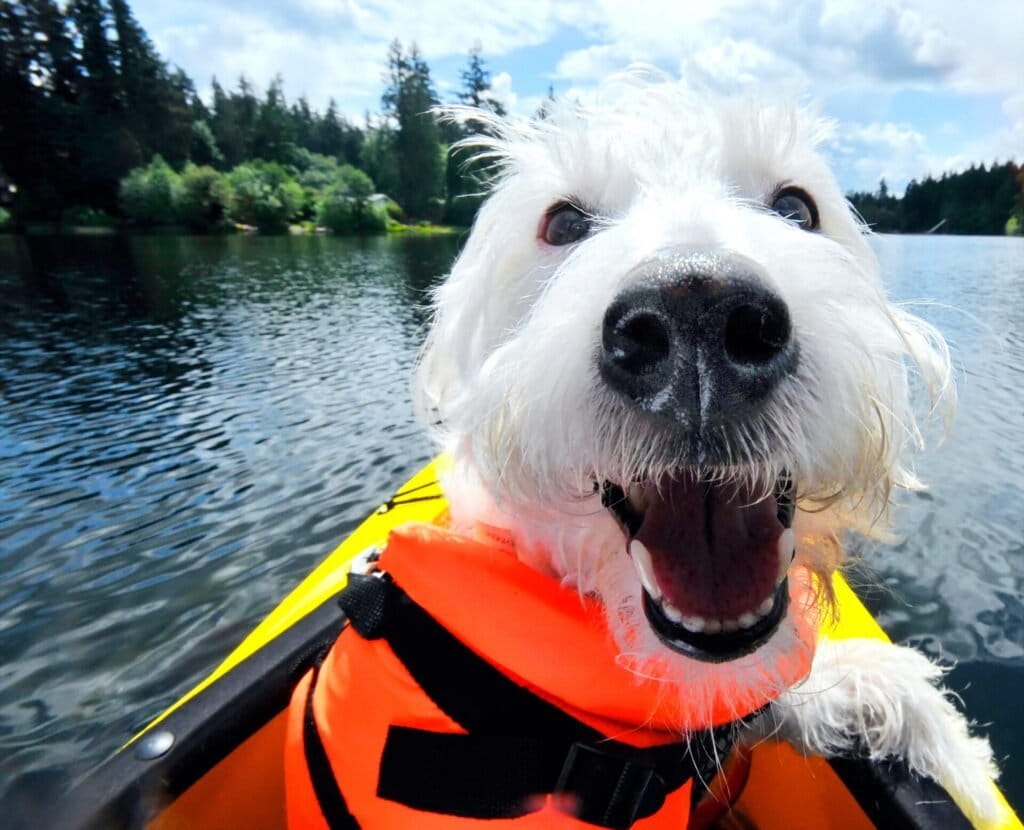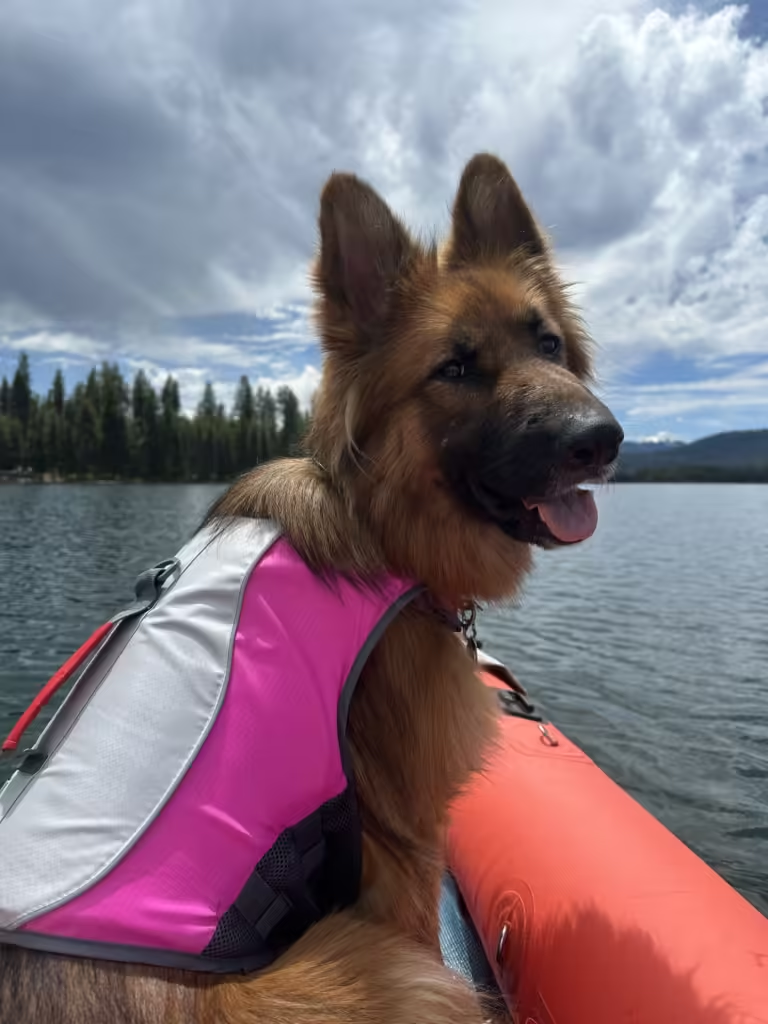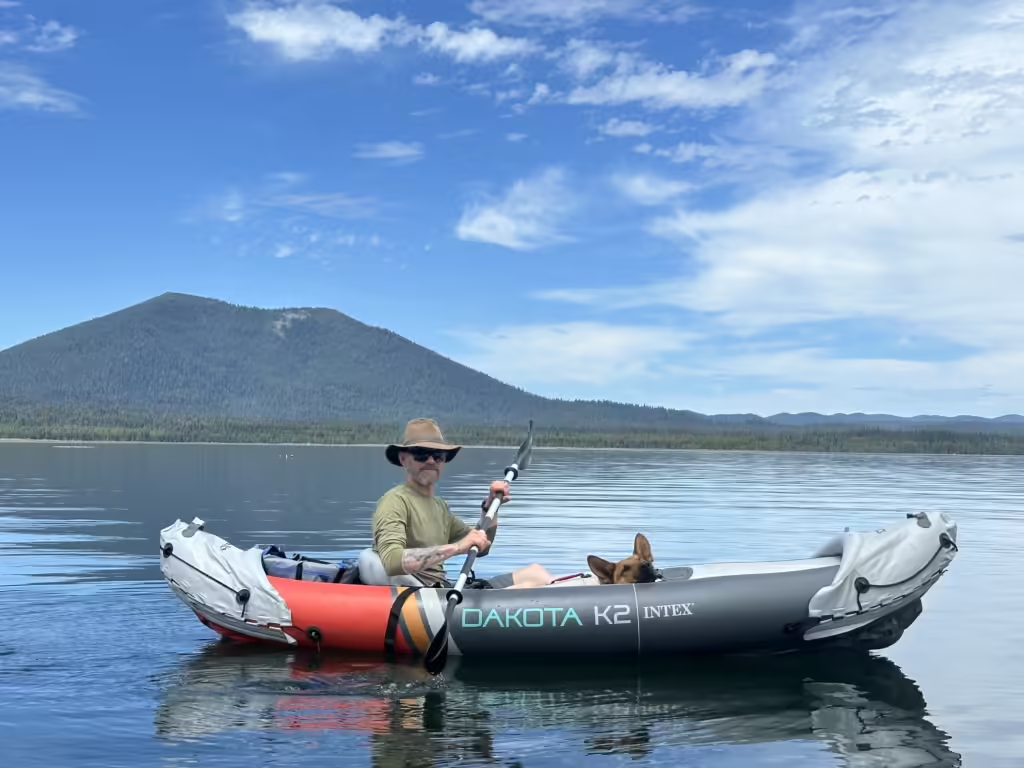Kayaking with Dogs: Tips for Making Paddling Adventures Unforgettable
Kayaking with our dogs turns a simple paddle into a real adventure. There’s just something about sharing the water, fresh air, and sunshine with our furry friends right by our sides.
With a little planning and the right approach, we can safely kayak with our dogs and make amazing memories together.

We all have our worries—will our dogs stay calm, will they enjoy the kayak, or is it even safe? The good news? We’re not alone.
Many of us have questions about what gear to use, how to prepare, and how to pick the best kayak for our outings. There are lots of helpful tips and tricks for kayaking with dogs that make the whole experience smoother and more enjoyable.
Before we head out, it helps to know exactly what we need and how to make sure everyone, paws and people, have the best time possible on the water.
Key Takeaways
- The right kayak and preparation set us up for safe, fun trips.
- Training and planning are key for successful outings with dogs.
- Good habits help us handle challenges and enjoy paddling together.
Choosing the Best Kayak for You and Your Dog

Finding the right kayak means thinking about our dog’s safety and comfort as well as our own. Not all boats are created equal, and what works for one pair might not for another.
Whether we want space, stability, or just a good spot for treats, picking the ideal boat can make our adventures more fun.
Factors to Consider When Selecting a Kayak
When we’re looking for a kayak for us and our dog, size matters—a lot. Our dog needs enough room to sit, stand, and turn around without feeling cramped.
Big cockpits or sit-on-top kayaks give them that freedom and make it much easier for us to reach them if they get nervous. Stability is huge.
The less “tippy” our kayak is, the better, especially if we have a wiggly pup. (Ask me how I know.) 🙂 Wider, flat-bottomed kayaks usually feel steadier and help prevent surprise swims.
Weight limits are important, too. We’ve got to add up our weight, our dog’s weight, and any other gear.
If the total gets close to the kayak’s max, it’s safer to bump up in size. Getting a kayak with a weight limit well above our needs gives us peace of mind.
We should also think about where we’ll paddle. If we stick to calm lakes and gentle rivers, most recreational kayaks will work.
But for choppy water or longer adventures, we might want extra features like dry storage or reinforced hulls.
Pros and Cons of Kayaks vs Canoes
Kayaks and canoes each have their advantages when we’re paddling with our dogs. Kayaks are more popular for solo trips.
Sit-on-top models in particular make it easy for dogs to hop in and out, plus they’re simpler to clean if a wet dog jumps aboard. On the flip side, canoes have way more open space.
Bigger dogs (or even two dogs) can stretch out and relax. The high sides help keep splashy paws inside, and there’s room for extra gear.
Canoes can be heavier and harder to paddle solo. They also take on more wind.
Kayaks tend to be lighter and quicker in the water, but smaller cockpits can feel tight for large or energetic dogs. We should ask ourselves how much room our dog really needs and whether we usually paddle with a partner or alone.
Being honest about our own paddling style will help us choose the right boat.
Recommended Kayaks for Dogs
A few kayaks come up over and over in dog-loving circles, and with good reason. The Ocean Kayak Malibu Two is super popular for its roomy design and stability.
Dog owners love it for its sit-on-top style and plenty of flat space for furry friends to relax. It’s known as the most popular tandem sit-on-top kayak in the world.
The Old Town Malibu Two XL sit-on-top kayak is the perfect all-around family boat, comfortably fitting two adults and a small child or your furry companion. Ideal for fun, relaxing outings on scenic lakes, this versatile kayak makes every adventure memorable for the whole family.
For those of us who want a kayak just for ourselves and one dog, recreational sit-on-top kayaks are usually easiest. Look for models with nonslip decks, roomy cockpits, and high weight limits.
Adjustable seats and footrests are nice touches, too. If easy access to our dog is a priority, or our dog is extra large, it helps to choose kayaks built with extra space in the cockpit or open deck.
Some popular brands even make dog-friendly accessories like non-slip mats or extra padding.
Types of Kayaks for Paddling With Dogs
Finding the right kayak for us and our dog makes all the difference in safety and fun. What matters most is comfort, stability, and how easy it is to travel with our furry friend.
Inflatable Kayaks: Lightweight Options

Inflatable kayaks always surprise folks with just how sturdy and roomy they are. We can pack them in the car trunk, hike them to a lake, and set them up in minutes. We use an Intex Excursion Pro, and it’s been perfect. I’ve had this kayak for 3 years and counting.
Includes Deluxe 86in Kayak Paddles and High-Output Pump SuperTough PVC Adjustable Bucket Seat 2-Person 400lb Weight Capacity
They’re usually made from tough, puncture-resistant materials, which is great since dog claws can be sharp. (I put a yoga mat at the bottom of mine to be safe.) What really stands out is the way inflatable kayaks can handle bigger dogs or active pups that fidget a lot.
They float high and don’t tip easily, which keeps things stress-free for beginners or anyone nervous about balance. Some popular models even offer wide, flat decks.
That gives our dog plenty of room to sit, lay, or switch positions without crowding us. We just have to make sure to rinse and dry them well after paddling, so they last longer.
Pros:
- Easy to carry and store
- Budget-friendly compared to most hard-shells
- Handles bumps and dog movement well
Cons:
- Not as fast as rigid kayaks
- Need to check for slow leaks
- Some extra drying time before packing up
Folding Kayaks: Portability and Convenience
Folding kayaks, sometimes called origami kayaks, are a game-changer if we live in small spaces. Their magic is that they collapse down to suitcase size, so we can take them on public transit or stash them in a closet.
Assembly only takes a few minutes, and it’s pretty straightforward once we get the hang of it. Some folding kayaks use durable, corrugated plastic that stands up nicely to claws and sandy paws.
There’s room for a medium dog up front or between our knees, depending on the model and our dog’s size. They’re lighter than many hard-shell kayaks and sturdier than most inflatable ones.
We’ve seen Oru Kayaks mentioned often for their unique design and toughness.
The Oru Kayak Lake is a stable, beginner-friendly kayak that's perfect for paddlers of all ages. Lightweight and compact, it fits easily in your car's back seat or trunk, and assembles in just minutes—so you can hit the water and start your adventure right away.
Why we might love them:
- Super easy to store in cars or small apartments
- Quick setup and pack-down
- Many hold up well to regular use with dogs
Things to watch for:
- Higher price tag
- Weight limits can be lower than hard-shell or inflatable options
- Some dogs may need time to adjust to the surface texture
Tandem Kayaks for Extra Space
Tandem kayaks are a solid pick if we want room to spread out or paddle with a friend and our dog. They often have wider, more stable hulls that make it easy for dogs to move around without rocking the boat too much.
Both experts and real-life paddlers recommend tandems for balance and space, especially for big breeds. We can choose between sit-on-top or sit-inside tandems.
Sit-on-top styles give our dog open space to relax next to us or in front of us, while sit-inside tandems offer more shelter from splashes. Some kayaks have special pet pads or non-slip surfaces, making it more comfortable for our pups.
If we’re a couple or want a family member to help paddle, tandems let everyone be included (even our dog might get a petting hand free). With the right model, we don’t have to sacrifice stability for adventure.
Perks:
- Lots of room for large or multiple dogs
- Stable enough for standing, sitting, or lying down
- Great for social paddling
Potential trade-offs:
Will need more garage or storage space
Harder to transport alone due to size
Heavier than other kayak styles
Preparing Your Dog for Kayaking Adventures
Getting ready for kayaking with our dogs takes a little planning and patience. It’s all about helping them feel safe, confident, and comfortable on the water with us.
Introducing Your Dog to the Water
Let’s start slow, especially if our dog hasn’t spent much time around water. We can choose a calm, shallow area like a quiet lake shore or even set up a kiddie pool in the backyard.
It’s best to let our pup sniff, explore, and dip a toe at their own pace—there’s no rush. We might use treats or their favorite toy to make the water fun and positive.
If our friend seems nervous, we can just sit with them at the edge and offer gentle encouragement. Sometimes, just wading in together can help them feel braver.
Some dogs might take a few tries before they’re willing to splash around. That’s okay. We’re building trust and excitement for our future adventures.
Training Your Dog for Kayak Safety
Before hitting the water, we need to show our dogs how to act around the kayak. First, we let them sit in the kayak while it’s still on dry land.
This gives them time to sniff, explore, and get comfy with the shape and feel—no pressure, no rush. Treats help a lot here, along with calling them in and praising any calm behavior.
We practice basic commands like “sit,” “stay,” and “leave it.” Out on the water, these commands become even more important.
Dogs get excited and distracted, just like we do. We keep training sessions short, make them fun, and slowly add new challenges—maybe wobbling the kayak a little or moving it closer to the water’s edge.
For extra tips, there’s a practical guide on training and best practices that’s worth a look.
Essential Gear for Dogs
Safety is always first, so a dog life jacket is non-negotiable—even for the most confident swimmers. We look for one that fits snug, has a sturdy handle, and comes in a bright color so our pup stands out.
Some jackets add reflective strips or a spot to clip a leash, which is handy. A non-slip mat for the kayak floor helps our dog keep their footing, especially if things get a bit shaky. We use a thin yoga mat and it works great.
We always pack water, a bowl, and a few snacks to keep everyone hydrated and in a good mood. A short leash and a treat pouch are lifesavers for quick rewards and control.
Having gear within reach keeps us focused on the fun, not fumbling around. Being prepared in these ways helps us fully enjoy our adventures.
Packing and Planning a Kayaking Trip With Your Dog

We want our time on the water with our dogs to feel fun, safe, and as stress-free as possible. That means packing smart and thinking about safety before we even walk out the door.
Items to Bring for Your Dog
Let’s throw together a doggy checklist to keep things simple. Here’s what we always pack:
- Dog life jacket: Even strong swimmers need a little help. Make sure it fits right and has a sturdy handle.
- Leash and harness: A harness makes loading and unloading easier and safer. Don’t forget a reliable leash.
- Towel: Wet dogs are happy dogs, but a towel helps dry them off and keeps the car cleaner.
- Dog bowl and water: Fresh water is a must, especially on hot days. Collapsible bowls are great for travel.
- Dog treats or food: Snacks keep our pups motivated and help with training on the go.
- Doggy first aid kit: Just the basics—bandages, tweezers, and any meds your dog might need.
- Comfort items: Bring a favorite toy, blanket, or some non-slip padding. We use a small yoga mat to stop paws from slipping. This little touch makes a big difference (see more tips on kayaking with your dog).
If we’re planning a longer trip or a special adventure, we might add a few extras to the list.
Safety Precautions for Paddling Together
Safety lets us relax and enjoy the ride with our furry sidekick. Using a dog life jacket is one of the smartest things we do—even dogs who love water can get tired or spooked.
We always double-check the fit and make sure there’s a good handle for lifting or steadying them. Before any trip, we help our dog get used to the kayak on land. This lowers their nerves and helps them see it as a safe place.
When we launch, we look for a calm, easy spot so neither of us has to rush. That helps our dog feel steady and secure from the start.
We steer clear of busy, motorized boating areas since noise and wakes can rattle our dog. Calm water just makes everything better. If our dog’s new to kayaking, we keep trips short and build up their confidence slowly.
We keep our eyes on them, using encouragement, treats, and praise along the way. Our dog always wears an ID tag and stays leashed until it’s time to settle into the kayak. Little steps like these go a long way, and experienced paddlers on Paddling.com and the AKC agree.
Best Practices for Kayaking With Dogs
When we bring our dogs along, it’s up to us to keep them happy and safe. The small stuff matters—from how we act around others to noticing even tiny changes in our dog’s mood.
Dog-Friendly Kayaking Etiquette
Let’s respect nature, other people, and the animals we meet out there. We keep our dogs leashed near busy launch areas and do our best to keep things chill for everyone.
Quiet greetings and giving other paddlers plenty of space go a long way. We always clean up after our dog, even if it means paddling to shore with a waste bag tucked in a dry container.
If we pass other kayakers or spot wildlife, we keep our dog close and calm. Barking or splashing can throw off both people and animals, so a relaxed vibe is the goal.
Plenty of water breaks keep our dogs comfortable. We don’t let them drink from lakes or rivers—nobody wants a sick pup.
For more ideas, there’s a solid guide to kayaking with dogs that’s worth checking out.
Reading Your Dog’s Comfort Level
Paying attention to our dog’s mood is key to any good trip. Dogs tell us how they’re feeling through body language.
If our pup is panting more than usual, whining, shivering, or trying to scoot away, it’s definitely time for a break. We reward calm, steady behavior with treats and kind words.
Short trips work best in the beginning, so our dogs learn that kayaks are safe and fun. If we spot signs of stress, we head for shore and let them relax for a bit.
A cozy setup matters. Padding or a nonslip mat helps our dog feel secure. Their favorite toy or blanket can work wonders, too.
We keep an eye out for any changes in their attitude—sometimes even a sunny day or a noisy boat can be too much. By noticing these things, we make every outing safer and way more enjoyable. For more tips, check out these training tips for kayaking with dogs.
Common Obstacles and How to Overcome Them
Kayaking with our dogs feels awesome, but sometimes things don’t go as planned. We’re bound to run into a few hiccups, and learning how to handle them keeps the adventure rolling.
Managing Unexpected Weather
Weather changes fast on the water. One minute it’s calm and sunny, and then suddenly clouds roll in or the wind picks up.
Honestly, nobody likes getting caught off guard by rain or cold. We always check the weather before heading out and pack for whatever might happen.
Stashing a small waterproof bag with a towel, dog jacket, and extra water really helps. If the weather turns while we’re out, we look for the nearest shore and take cover.
Even light rain can make things slippery and stressful for our dogs. Cold paws are no fun, so a dry towel is a must.
We keep our voices steady and upbeat to help our dogs stay calm when the weather gets weird. Honestly, it’s about showing them we’ve got it together, even if we’re winging it a little.
Dealing With Distractions on the Water
Wildlife, other kayakers, and random noises can grab our dog’s attention in a flash. Birds swooping low or fish jumping nearby can tempt even the chillest dog to leap out and chase.
Practice helps our dogs stay focused—short, easy trips are great for building confidence. We give treats for calm behavior and pack a favorite toy for something positive to focus on.
Making a special spot for our dogs in the kayak, like a mat or blanket, really helps them settle.
Gentle reminders and lots of patience help our dogs learn that staying put is the best way to enjoy all the action. We’re all figuring it out together, honestly.
Making the Most of Your Kayaking Experience

Sharing the water with our dogs gives us a chance to make awesome memories and explore new spots together. Every trip can be an adventure if we pay attention to the little moments and pick places our dogs will actually enjoy.
Building Positive Memories Together
The joy of kayaking with our dogs? It’s honestly in the little things—nose bumps, tail wags, and that first splash as we push off. We should keep treats handy to celebrate when our pups settle calmly or handle something new without fuss.
Snapping a quick photo or stopping for belly rubs makes the whole day feel special. Packing a favorite toy or a cozy towel helps our dogs feel at home out there.
A soft bed or non-slip mat adds comfort, just like Rover and Old Town suggest. I mean, who doesn’t want their pup comfy?
Talking to our dogs during the trip really helps. Sometimes, just a calm voice is all it takes when they spot something weird or hear a strange sound.
Every paddle stroke? That’s another chance to build trust and share a little adventure together.
Favorite Destinations to Explore
We get to choose where our kayak journeys lead, and honestly, the right spot changes everything. Calm lakes and slow-moving rivers make the best starting points for beginners.
These places let us and our pups enjoy the view without fighting the current. Paddle-in picnic spots, dog-friendly beaches, and small islands are all solid picks.
Some areas even have dog parks by the water, so our dogs can run and play before or after paddling. That’s a win for everyone.
Before heading out, it’s smart to check local rules about dogs and water access. Planning ahead keeps things smooth and way less stressful.
Frequently Asked Questions
Kayaking with our dogs can be an awesome adventure, but it takes a little prep and some smart choices. We want to stay safe, keep our dogs comfy, and pick the best gear and locations.
How can I make sure my dog is safe and comfortable while kayaking?
We always start with a life jacket that fits our dog well. That way, they stay safe if there’s a splash or a sudden move.
A slip-resistant mat or pad in the kayak gives our pup a secure, cozy place to sit. We pack fresh water, offer regular breaks, and skip paddling in extreme weather.
Watching for signs of stress or tiredness lets us know when it’s time to head back. No shame in calling it a day early if our dog needs it.
What types of kayaks work best for bringing along my furry friend?
Sit-on-top kayaks usually give us more room, and dogs can hop in and out easily. If our dog is small, a sit-inside kayak can work, but it’s a tighter fit.
Wider, stable kayaks are better for dogs new to water since they don’t rock as much. Some kayaks come with extra storage or a big cockpit, which makes paddling with our pup a lot easier.
For more ideas, check out this guide to choosing the best kayak for dogs.
Could you share any tips for training my dog to enjoy kayak trips?
We always start on dry land, letting our dog sniff around and get used to the kayak. Treats and praise go a long way in making them interested.
Sometimes, we’ll feed them treats while they sit calmly in the kayak. Once they seem relaxed, we try short, calm water trips.
Patience is key, and every good experience helps build their confidence. There are some great tips out there, like these steps for getting your dog used to kayaks.
Are there specific life jackets for dogs to wear while kayaking?
Yep, there are life jackets made just for dogs. We look for ones with adjustable straps, sturdy handles on the back, and bright colors so we can spot our pup easily.
It’s important to try the life jacket on before the trip. We want to make sure our dog can move comfortably and that the fit is snug but not too tight.
What should I know about kayaking with my dog in different water environments?
Calm lakes and slow rivers work best for most dogs, especially if they’re new to it. These spots are more relaxing and usually safer for everyone.
Rough water or strong currents make things a lot tougher, so we avoid them unless we’re both really experienced. Even on calm water, staying close to shore the first few times just makes sense.
Can you suggest any dog-friendly kayaking spots to check out?
Local lakes, ponds, and slow rivers can be perfect for us and our dogs. I usually look for parks or recreation areas that welcome dogs on the water.
Easy entry points make things so much less stressful. Sometimes, I stumble on hidden gems just by chatting with other paddlers.
Searching online for dog-friendly destinations helps too. Paddle clubs and pet-friendly travel blogs often toss out some pretty solid recommendations for our next outing.e them time to adjust.











